35 Alternative or Cultural Methods and Approaches
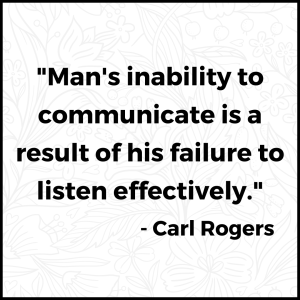
What are other means for creating argument?
Rogerian theory suggests that the audience is more likely to listen to and be persuaded by an argument if the writer recognizes their perspectives as well. This “finding common ground” demonstrates that the writer has taken others into consideration prior to drawing his/her own conclusion. Hence, Carl Roger’s quote noted above: “Man’s inability to communicate is a result of his failure to listen effectively” stresses the importance of listening before responding. The following Venn diagram illustrates two people finding common ground in the argument about dogs vs. cats by one person listing attributes of dogs, such as barking and security and the other person listing attributes of cats, such as quiet and independent. The middle, overlapping section, or common ground, lists attributes of both, such as four legs, fur, and companionship.
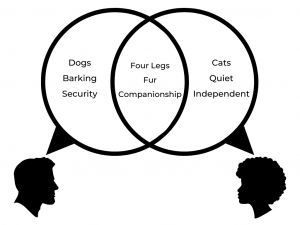
Thus, within your body paragraphs, include counterarguments and acknowledge the merits of those arguments. Doing so will only demonstrate your understanding of the issue and strengthen your own argument. Just be sure to rebut the counterarguments by explaining the benefits of your stance over that of the counterarguments.
Attribution
Quotation from Carl Rogers. On Becoming a Person: A Therapist’s View of Psychotherapy. Houghton Mifflin, 1961.
Examples
For more information on Rogerian, FYC at USF has posted an excellent YouTube video explaining the attributes of Rogerian Argument.
Here is a graphic organizer to help you build your argument by reacting to counter arguments: Counterargument Graphic Organizer
Another Approach to Argument:
Besides Rogerian theory, Bitzer’s Rhetorical Situation gives yet another approach to argument. Philosopher Lloyd Bitzer contends that a rhetorical situation has to have specific elements.
- First, a problem, a need (exigence) must require some type of discourse in order for the situation to change.
- Second, the audience must be people who are capable of changing the situation, not merely readers or bystanders.
- Additionally, constraints govern the rhetorical situation by providing specific elements, such as “beliefs, attitudes, documents, facts, traditions, images, interests, motives, . . . “ as well as elements hinging on the writer, such as “characters, logical proof, style” (Bitzer 8).
According to Bitzer, these three elements must be in place for a rhetorical situation to exist. Otherwise, a piece of discourse is not an argument, but rather some other type of text, such as a report or a reflection or a poem. Moreover, knowing these elements of the rhetorical situation helps a writer determine the topic, the audience, and the parameters of the situation, which in turn help shape the entire argument.
Attribution
Bitzer, Lloyd F. “The Rhetorical Situation.” Philosophy & Rhetoric, vol. 1, no. 1, Jan. 1968, pp. 1–14, JSTOR.
In The Write Place: Guides for Writing and Grammar, L. Lennie Irvin offers a thorough representations of the rhetorical situation.
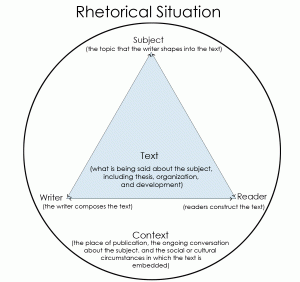 The Rhetorical Situation
The Rhetorical Situation
Although your message (thesis) may stay the same, your purpose may change depending upon your choice of audience or vice versa. Depending upon the audience, you may adjust your diction (your choice of words) or the kind of support you choose to include depending upon your audience. Writing, thus, involves many choices and a close attention to and balancing of many constraints that can shape your communication. Although Flower and Hayes presented the simple triad of goals, knowledge, and the written text as elements writers needed to balance, the following graphic depicts a more complete description of these various elements and constraints of the writing situation.
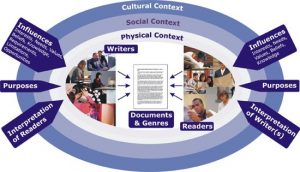
Discovering and maintaining an appropriate and productive balance and alignment of these various constraints–finding one’s rhetorical stance–is one of the most challenging and important things to do as we write. We want what we write to appeal to our audience in order to achieve our purpose within the given context. And since we are writing for school, we importantly need our writing to fit the assignment. Finding this balance and discovering what we mean to say as well as the language to say it is not easy–and takes a process to achieve.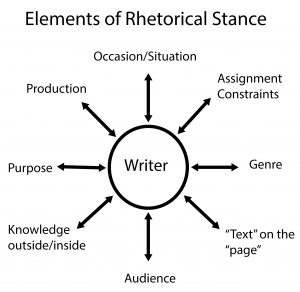
Example
Here’s a graphic organizer to help you analyze an author’s rhetorical situation: Rhetorical Guide Graphic Organizer
Attribution
“A Word or Two on the Writing Process,” The Write Place: Guides for Writing and Grammar, Irvin, L. Lennie, CC BY-NC 4.0, https://www.lirvin.net/WGuides/wprocess.htm.
